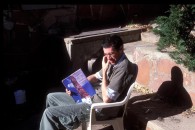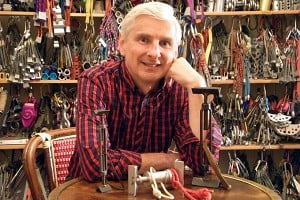
Niall Grimes writes about Crispin Waddy's recent ascent of Master's Edge E7 6c at Millstone and how watching friends on the route brought back memories of his own experience on the intimidating arête in the '90s...
His breathing has quickened, the previous moves making him draw breath hard from the chest. Fighting with criss-crossed feet he gets stood in the deep holes and with the barn door held shut, pauses to gasp awhile. Over a few moments I hear the breaths calm down. Breathe. Breathe. Breathe. Then:
'Right, watch me.'
You better believe I am watching. Up the arête he goes, farther and farther from the runners. I look at the ground. I look at the rope. I look at the runners and his distance above them. My mind can't help but think about connections.
Pat was shunting Remastered Edge. This is a Pete Whittaker creation from an era when he and Wide Brother Tom Randall were into doing brilliant routes on the wrong side in the hope of collecting glory by association. I had come along to belay Crispin Waddy on Master's Edge. I'm assuming you know what Master's Edge is – the Peak District's pre-eminent E7 following an architectural arête with crucial gear at half-height and a last-move crux. I was there in pure factotum-mode and had little to do between belay duty. I sat on a lump of rock and watched Pat.
It was a beautiful January day. Snow lay upon the ground and the low golden sun smiled its warm light bright on the rock. A t-shirt and jumper day, if you kept moving. From my lump I watched Pat shunt upwards; on the left it looked desperate, much more technical than its right-hand master. I enjoyed the sun on my back and in a very chilled state gazed at him. He was bright in the sun, but I soon became aware that I was gazing not at Pat but at his shadow. It mimicked his climb, but ascended not the arête but the corner of Green Death behind.
***
I was once going to the cinema with a friend – a non-climber of all things – and waited in her hall while she got ready. In the hall was one of those framed prints of Stanage Edge you see sometimes and it caught my gaze and I stared deeper and deeper into its details. Across a scape that must have covered two or three kilometres, my attention was drilling into spaces that were a few centimetres wide: the flake on Silica; a pebble on White Wand; the Rock 4 slot on Wuthering. Such was the depth of connection I had with these and a million other fingertips of rock in the photo. I could feel them. Then we left for the cinema.
And so back at Millstone, where Pat's shadow made me think of how my own shadow had passed along these climbs and in a content relaxation, I allowed myself to indulge in the memories of the climbs and my climbing of them.
On the left, the twin E2 pitches of Great West Road; is this secretly the hardest of them all? A slippery-as-hell layback on the first pitch where you stab in nuts like they were cams and hope they might catch if you fall, an outcome that seems likely. Then a big ledge. Then the upper arête, which is unreasonably out-there, annoyingly technical, distastefully insecure and with your lead rope only clipped into one old piece of junk that has the unmitigated gall to refer to itself as a runner. A brilliant route, worth three stars of anybody's money.
To the right sits a gallery of hard classics bound on one side by Master's Edge and holding centrally three of the Peak's great E5s.
Edge Lane – buzz caner, a big cold hard edge. And look, can you see? All the way up there? That's the crux. Hell yeah! I used to come when I was getting into the 5s and do the lower moves. But I always knew I wasn't really going up, so I always came back down. And why not? A 5c move at thirty feet was quite offputting.
Until one day when Richard and I went out midweek. Richard had previously top-roped it and wanted to solo it and I thought this could be the nudge I needed. He went up again on a rope that warm April afternoon and I studied his steps and reaches, internalised them into my own frame and style. He lowered down and I went, this time knowing I was going up.
The solo ascent was pure joy. I found a few rests then was stood hands-off below the crux. A smeary step up, held on by undercutty sidepulls. Up we go, full 5c mode, then creep to the jug. Yes! It was done. Richard soloed straight after and on the ground below we hugged and danced. I had deliberately watched someone climb it to make it easier for me, so I guess I lose a style point, but being there and then with Richard I knew I had scored high in friendship points, and I know which I treasure more.

Straight after I grabbed a rope, scrambled to the ledge and clipped the belay of Master's Edge. From here I set off up the upper hulk of Great Arête, another at that beautiful grade of E5 5c. By contrast I knew nothing about this one and had never even spoken to anyone who had done it.
With the belay of Master's clipped it is arguably safe, but the consequence of a fall hardly bears thinking about – taking the ride down the entire height of the wall with the rock rocketing by in front of your face as you fall twice the height of Master's Edge. Comical. I felt utterly relaxed on the route, so in control, and it passed by all too quick.
A warm summer evening and Donie asks for a belay on Green Death. Easily he reaches the peg and exclaims in horror that it's only held in by a piece of cardboard! But he's cool and, crux done, tops it out and asks if I want a go 'cos he can leave the quickdraw. Judging by the ease of his ascent, I reckoned this was my chance to hoover up the last of the three E5s.
'Yes please!'
Green Death is an E5 5c with a 6b start. The thing about the 6b start is that it's an entrance exam to the culminating corner. The culminating corner teeters ever tighter to an insecure 5c crux to reach a peg (which is at the same height more or less as the finishing jug on Master's Edge). If you can't do the 6b start, you have no business being in the corner.
On that summer evening, hungry for the tick, I tried and failed four times to leave the ground before I asked for a leg-up to reach a ledge at three metres. Up I tinkled (unaware of what imposter syndrome was back then) remembering how much I hate corners, creeping towards the cardboard peg. With no style or dignity, I pulled the crux and, without wanting to even look at it, clipped Donie's quickdraw before numbly pushing on to the finish trying to count how many E5s I had done so far that year.
But oh no! The top-out was a sloping mantel nightmare. My triceps jellied and with my cool long gone I pushed it out millimetres at a time. I swear to god I felt the odds were stacked against me and I wasn't going to make it (one of two such experiences in my climbing life) and all the time echoing in my head were Donie's words: The peg is only held in by a piece of cardboard.
I was probably there for three minutes, maybe four, which doesn't sound long when compared to a lifetime, but spending four minutes on one move is what one might call indulgent. And that one move was haunted by my judgement: I'm probably going to fall off and if I do, I'm probably going to hit the ground and die.
Emotions so intense are a privilege and, along with friendships, amongst the great gifts that climbing has bestowed upon me.
Master's Edge definitely inspired feelings of imposter syndrome. E7 was a grade for good climbers and I knew what I was. The rule among my peers at the time was that below E5/6 you had to do ground up. E6/7 you could top-rope first. Well, I say 'peers', I wasn't their equal; I looked up to them. I peered up to them. Hang on, maybe they were my peers!
So, my ascent of the other three essentially stamped my passport to get on Master's Edge on a top rope. It felt so hard and improbable, especially one move already above the shot holes. You have to put a high left foot on a bumpy nubbin on the arête and you can't ever imagine this bumpy nubbin will take your weight, but you have to press down hard on the bumpy nubbin while laybacking the flat smooth arête.
Even on top rope it is scary, but the next thing you know you are leading it, staying calm as you place a high left foot on the bumpy nubbin, all those doubts you'd worked on shouting for attention and somehow you silence them. From here, going up the arête, gear a long yawn below, were moments of ferocious calmness. Moments where I was giving everything I was and everything I had ever been to moving perfectly upwards towards a lunge to a finishing jug. It's hard to imagine what this does to your body and mind.
***
The sun was still warm on the back of my head and I was still enjoying Pat's shadow climbing Green Death and Pat was clearly still enjoying climbing Master's Edge on the wrong side. And why not, it's a free country! I realised I'd been lost inside dreams of glory. Albeit some of the most intense moments of my life, of fear, of triumph, of friendship, of connection to the world through my chosen 'earth wire' of rock but still, the past is a good place to look at, but not a good place to stay in for too long.
It had been a long time since I had done these climbs and while I could still describe the moments in words, could I really still recall the feelings? How the undercutty sidepulls on Edge Lane were? How my jellied triceps felt on Green Death? What the bumpy nubbin tasted like to my boot rubber? Were these still my trophies to keep on the mantelpiece or should they now be put away in the attic or better still, chucked in the bin? I still have the guidebooks with blue ink ticks but are they still my ticks, me in 2024?
A documentary I watched on TikTok said the body's cells regenerate every 10 – 15 years. Apart from my fillings and my rope, nothing at Millstone today was here when I did these routes. The thought had a sobering edge as Crispin called to me that he was ready to lead and for me to come and belay.
It's so cool. Crispin decided at the end of last year he wanted to push himself on Master's Edge. It's taken some dedication; fighting injuries and life's other taxes and on cold, dry-enough days he has come to the crag alone, dropped a rope and shunted and worked and pushed. Phoning around for belayers and company, balancing on that knife-edge between needing support and not wanting the pressure of everyone knowing. I was pleased to come and belay – it reminded me of belaying Swedish Rich on it (as featured in Hard Grit).
My reflections were still on my mind as he set off and as he moved upwards, while watching him and the rope. He climbed the lower arête to the famous shot holes and placed the route's last protection, then pushed on to a very poor rest above. He was breathing quickly and heavily and there was tension in the air.
I checked the rope, the runners, my ATC, and while he spent some minutes getting his breathing under control, I pondered the connections not only in the belay system but between me and my past climbing. Musing as to whether if I could authentically connect myself to what Crispin was now doing, where Crispin now was, many years later.
'Right, watch me!' he called. He moved boldly up a couple of moves then stepped his left foot onto the arête. The bumpy nubbin, I realised!
When I was a child in physics class, we were discussing magnetism and magnetic fields. There was a piece of paper and onto it the teacher scattered a bag of iron filings. Like little miniature, black hundreds-and-thousands, they lay scattered randomly in every direction. Then teacher put a magnet under the paper and everything changed. The filings knew what to do and snapped into ranks, end to end, into black rainbows hunting out invisible directions. An instinctual phalanx of purpose built into their very atoms.
Up onto the bumpy nubbin he pushed and as I watched every cell in my body snapped like magnetised iron into its flux. Why? Because it knew! Everything in me knew and understood that feeling of this move and the moves above. A jolt of recognition went through me connecting me to Crispin, me to the me who once did Master's, who did Great Arête and Green Death and who danced with joy with Richard as we both stood below Edge Lane looking up at what we had just done.
'Come on, Crispin,' I whispered. 'Cos I knew.
- ARTICLE: Stanage - A Journey Through the Grades 1 Jan
- ARTICLE: My Map of the World 11 Jul, 2024
- GEAR NEWS: Boulder Britain 2020: Bigger, Better, BOULDER! 20 Oct, 2020
- PODCAST: Jam Crack Podcast 6 Dec, 2016
- The Pitter-Potter of Giant Feet: 'Meeting' Dean Potter 20 May, 2015
- REVIEW: Roca Verde Climbing Guide 28 Jul, 2014
- Coming Home for Christmas 24 Dec, 2011
- A New Guidebook: Boulder Britain 22 Nov, 2011
- King Of The Crag 10 Sep, 2011
- Psychovertical by Andy Kirkpatrick 15 Jan, 2009



















Comments
Excellent.
Masterful. It’s always great to read Niall. More, more, more…
Great writing as ever from Grimer, especially liked the line 'the past is a good place to look at, but not a good place to stay in for too long'.
Captivating! Nice one Grimer.
Brilliant! More of this sort of thing please.